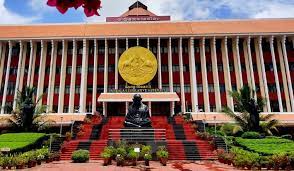What’s in today’s article?
- Why in news?
- What is the process to rename a state?
- News Summary: Kerala Assembly passes resolution to rename state as Keralam
- What does the resolution say?
- Origin of the names
- Demands for the modern state
- The state of Kerala after 1947
Why in news?
- The Kerala Assembly has passed a resolution urging the Centre to rename the state as “Keralam” in the Constitution and all office records.
What is the process to rename a State?
- Constitutional provision
- The Parliament has the power to change the name of a state.
- The Constitution of India gives the parliament power to alter the name of a state under Article 3.
- Article 3 of the Constitution explicitly lays down a procedure to alter the area, boundaries, or name of a state.
- Proposal
- The process of renaming of a state can be initiated by either the Parliament or the state assembly.
- The state legislature sends a proposal in the form of a resolution to the Central government.
- In Parliament, the bill cannot be presented without a recommendation from the President.
- The process of renaming of a state can be initiated by either the Parliament or the state assembly.
- Procedure
- States which are going to get affected by such changes, the legislation of that state must be presented with the bill.
- The provision to send a bill to the state legislature was not in the original Constitution.
- This process was added in the 5th Amendment Act, 1955.
- The State Legislature may present its views on the bill within the prescribed time period.
- The views or suggestions of the State Legislature are not enforceable against the President or The Parliament.
- If Parliament wants, it can dismiss the opinion of the state legislature.
- After receiving the suggestions of the State Legislative Assembly or after the expiration of the limited time period the bill goes back to the Parliament.
- Then the bill gets further deliberated upon in the Parliament.
- States which are going to get affected by such changes, the legislation of that state must be presented with the bill.
- Passing of the bill
- The bill is sent to the President for approval. After the said bill gets approved, it becomes a law and the name of the state stands modified.
- Other institutions involved in the process
- No Objection Certificates (NOCs) from several agencies such as the Ministry of Railways, Intelligence Bureau, Department of Posts, Survey of India and Registrar General of India are required.
- Once the Union Ministry of Home Affairs (MHA) receives the NOC from these institutions, it gives its consent to the resolution passed by the state.
News Summary: Kerala Assembly passes resolution to rename state as Keralam
- The Kerala Assembly unanimously passed a resolution urging the Central government to officially change the name of the State from Kerala to Keralam.
What does the resolution say?
- The name of our state in Malayalam is Keralam. States were formed on the basis of language on November 1, 1956. That day is also observed as Kerala formation day.
- The demand for a united Kerala for all Malayalam-speaking communities has been strongly raised right from the days of the freedom struggle.
- However, the name of our state in the first Schedule of the Constitution has been written as Kerala.
- This Assembly is unanimously requesting the Union Government to take immediate steps under Article 3 of the Constitution to change the name of the state to Keralam.
Origin of the names
- Origin of Kerala
- There are several theories about the origin of the name ‘Kerala’.
- The earliest epigraphic record that mentions Kerala is emperor Asoka’s Rock Edict II of 257 BC.
- The inscription refers to the local ruler as Keralaputra (Sanskrit for “son of Kerala”), and also “son of Chera” referring to the Chera dynasty.
- Origin of Keralam
- About ‘Keralam’, scholars believe it could have originated from ‘Cheram’.
- Scholars observed that the word ‘keram’ is the Canarese (Kannada) form of cheram.
- They described Keralam as Cheram — the region between Gokarnam and Kanyakumari.
- The origin of the term could possibly be from the root ‘cher’, which means to join.
- This meaning is clear in the compound word ‘Cheralam’, in which alam means region or land.
Demands for the modern state
- The people speaking Malayalam had been ruled by various kings and princely states in the region.
- It was in the 1920s that the Aikya (unified) Kerala movement gathered momentum and a demand for a separate state for Malayalam-speaking people came up.
- It aimed at the integration of Malabar, Kochi and Travancore into one territory.
The state of Kerala after 1947
- The merger and integration of princely states was a major step towards the formation of the state of Kerala after Independence.
- On 1 July, 1949, the two states of Travancore and Kochi were integrated, heralding the birth of the Travancore-Cochin State.
- When it was decided to reorganise states on a linguistic basis, the State Reorganisation Commission of the Union Government recommended creation of the state of Kerala.
- The Commission under Syed Fazl Ali recommended the inclusion of the district of Malabar and the taluk of Kasargod to the Malayalam-speaking people’s state.
- The state of Kerala came into being on November 1, 1956. In Malayalam, the state was referred to as Keralam, while in English it was Kerala.
Q1) What is State Reorganisation Commission?
The State Reorganisation Commission (SRC) was a body established by the Government of India in 1953 to examine and recommend changes in the boundaries and administrative divisions of states in India. The commission was formed in response to demands for the linguistic reorganization of Indian states, aiming to create states that were linguistically and culturally homogenous.
Q2) What is the geographical location of Kerala?
Kerala is a state located in the southwestern part of India. It lies along the Malabar Coast, which runs parallel to the Arabian Sea. The geographical coordinates of Kerala are approximately between 8.5241° N latitude and 76.9366° E longitude. It shares borders with the states of Karnataka to the north and Tamil Nadu to the east. Kerala is characterized by its lush green landscapes, diverse ecosystems, and a network of rivers, backwaters, and coastal areas. The Western Ghats, a mountain range that runs along the eastern side of the state, plays a significant role in Kerala’s geography by influencing its climate, biodiversity, and topography.
Source: Kerala Assembly passes resolution to rename state as Keralam: Origin of the two names | PRS India | India TV | The Hindu
Last updated on June, 2025
→ UPSC Notification 2025 was released on 22nd January 2025.
→ UPSC Prelims Result 2025 is out now for the CSE held on 25 May 2025.
→ UPSC Prelims Question Paper 2025 and Unofficial Prelims Answer Key 2025 are available now.
→ UPSC Calendar 2026 is released on 15th May, 2025.
→ The UPSC Vacancy 2025 were released 1129, out of which 979 were for UPSC CSE and remaining 150 are for UPSC IFoS.
→ UPSC Mains 2025 will be conducted on 22nd August 2025.
→ UPSC Prelims 2026 will be conducted on 24th May, 2026 & UPSC Mains 2026 will be conducted on 21st August 2026.
→ The UPSC Selection Process is of 3 stages-Prelims, Mains and Interview.
→ UPSC Result 2024 is released with latest UPSC Marksheet 2024. Check Now!
→ UPSC Toppers List 2024 is released now. Shakti Dubey is UPSC AIR 1 2024 Topper.
→ Also check Best IAS Coaching in Delhi






















